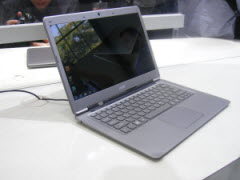
2013-07-19 17:10:56 / Posted by Michael Eric to Windows Tips
Follow @MichaelEric

It's easy to become confused by the sheer volume of technical decisions that you'll have to make when buying a preferable computer. You might wonder how much RAM you'll need, for instance, which processor to choose or which graphics card to pick, what display to look for, which hard drive will be best for you. There are so many issues that it's difficult to know where to begin.
Here is our checklist of specs to look for your all-in-one computer when you go shopping, followed by some tips and recommendations.
Display: In addition to multitouch capabilities (to support Windows 8), you should consider three other key factors: display technology, display resolution, and display size.
The all-in-one you buy should deliver graphics resolution of at least 1920 by 1080 pixels. Movies, digital photos, websites, and productivity apps will look great at this resolution on a 23- or 24-inch display. Move up to a 27-inch model, however, and you'll be able to make out the individual pixels because they'll be spaced farther apart to fill the larger area.
CPU: Choose an all-in-one with a desktop processor if you intend to perform in-depth photo editing, manipulate complex spreadsheets, or engage in other computing-intensive tasks. If your work is less demanding, an AIO built on a mobile CPU will be thinner and quieter, and will consume less power.
Memory: Look for systems with at least 6GB to 8GB of memory. Most all-in-ones offer relatively straightforward memory expansion, so you can add more if you need it. But you might discover that a limited number of memory slots will force you to replace existing memory modules with higher-capacity ones, rather than add to existing DRAM.
Storage: You'll want at least 1TB of storage. We've seen only a few AIO PCs outfitted with solid-state drives, but some higher-end models use small SSDs as a persistent cache for higher-capacity mechanical drives.
Optical drives: Upscale models should come with a least a Blu-ray player. If you're buying a custom configuration and don't think you'll ever watch Blu-ray movies on your computer, you can save a few dollars by including a less-expensive DVD burner in your machine.
Connectivity: If the machine you choose lacks an integrated Wi-Fi adapter, you can add it by plugging in an aftermarket USB adapter. Bluetooth support is convenient for connecting Bluetooth printers, tablets, and smartphones.
I/O ports: The all-in-one you select should have at least two USB 3.0 ports, but the more, the better.
TV tuner: An onboard TV tuner lets you watch over-the-air broadcasts on the AIO's display. If you subscribe to cable or satellite TV, however, you'll be much happier plugging a set-top box into the machine's HDMI input.
Trust, but verify: As with any PC purchase, unpack and set up your all-in-one immediately. Make sure you have all its accessories, and that the entire system is working.
Watch out second-hand: It is common that you will go to the second-hand market to look for a preferable computer. But watch out if it is unlocked by a password when you want to access to the system. If that, don't be disappointed, apply for Windows Password Recovery to solve it easily.
All in all, choosing a best computer for you really takes time. But keeping the recommendations above really helps.
Download SmartKey Windows Password Recovery Ultimate:
Recover all your Word, Excel, ppt, accesss office files password
Copyright©2007-2020 SmartKey Password Recovery. All rights Reserved.